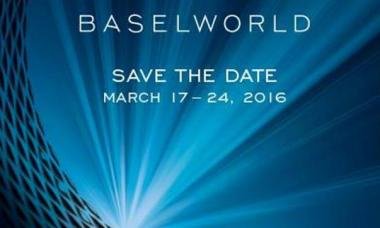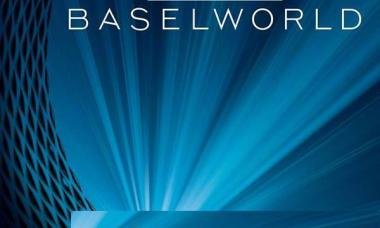BaselWorld is increasingly becoming a marketplace for premium, branded luxury
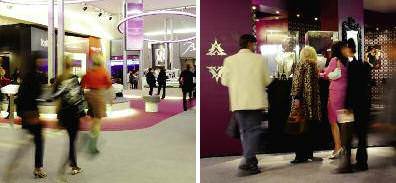
It was the fifth day of the BaselWorld watch and jewelry fair. During a rare moment of downtime in the old city’s packed-tothe- gills Campari Bar, René Kamm, CEO of Messe Schweiz, the exhibition company that runs the fair, let it be known that a few years from now, brands will be all that matter.
“That’s the future,” Kamm said, shrugging his shoulders and taking a sip from his Corona bottle. Sales trends at the show, which took place April 3-10, seemed to confirm this. Business varied wildly. From the mobbed passageways of Hall 1—home to booths for Patek Philippe, Rolex and watch brands who’d like to style themselves in one or the other’s likeness— to the vacant, harshly lit aisles of Hall 3.3, the newly christened “Hall of Impressions,” it was clear that Basel was cleaving into two shows, of which only one will survive.
Just don’t blame the organizers. The reality is we’re living in a “bifurcated market,” said David Arnold, senior vice president and group publisher of CurtCo Robb Media, LLC, during the keynote speech at the Gemological Institute of America’s GemFest, an annual forum whose theme this year was, appropriately, “Perceptions of Wealth vs. Reality.”
Drawing a distinction between ultra high net worth individuals and everyone else, Arnold said the increase in buyers for whom money is no object is one of the incontrovertible truths of the jewelry marketplace. “Thirty-six percent of the affluent population in the U.S. bought 55 percent of all watches and jewelry last year,” he said. “What should we remember when marketing to affluents? Wealth is growing worldwide.”
Arnold’s remarks were confirmed by fellow GemFest panelist François Curiel, chairman of Christie’s auction house, who said that, at auction, $100,000 is the new benchmark for colorless diamonds and $1 million is the new benchmark for rare colored diamonds, like the 2.26-carat purplish-red diamond that sold at Christie’s last year for $1.18 million per carat.
“It seems we defy the lows of the economy,” Curiel said. “So far in our world—I touch wood—everything seems to be doing very well.” In the luxurious confines of Hall 2, where the best-known jewelry brands were located, Curiel’s remarks certainly rang true. “The economy? I don’t know that we’re seeing it,” said Michael Beaudry, the American diamond designer, in his new booth. “We’re seeing a push forward by the wealthy and super-wealthy. It’s counterintuitive but that’s what’s happening, so we’re shifting our production into more exotic pieces.”
One market seemed to tower over the rest when it came to buying those pieces: the booming cities of the former Soviet Union, from Moscow to Almaty to Kiev, not to mention even farther-flung outposts rich with natural resources and oligarchs anxious to flaunt their newfound wealth.
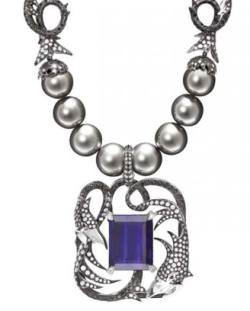 Stephen Webster, tanzanite Griffin necklace
Stephen Webster, tanzanite Griffin necklace
“We opened a boutique in Tatarstan,” said British designer Stephen Webster, noting that sales to Russian-speaking regions like Kazakhstan are up—way up. “I haven’t seen anyone down at all.”
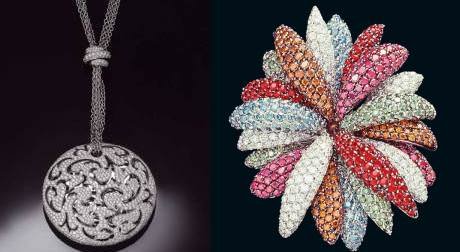 Palmiero, Arabesque pendant and Flowers ring
Palmiero, Arabesque pendant and Flowers ring
At Palmiero, where a new Arabesque collection inspired by mosque architecture was on display, Russian buyers had to contend with those from the Middle East—and again, not just the obvious place, Dubai, but from elsewhere in the region: Doha, Qatar, Saudi Arabia.
Indeed, in the selling frenzy that ensued as top buyers competed for one-of-a-kind jewels, the seesawing global economy was all but forgotten until the subject of one significant buying contingent came up.
“We’re missing the Americans,” said Helmut Müller, sales director of Christian Bauer, the German bridal manufacturer. “But until the election is over, I don’t see any changes. I’ve spent 25 years in the export business, 12 years in jewelry, and every election year is lousy for business.” So is the flailing dollar. Currency woes conspired to keep numerous American buyers out of Switzerland this year, including those who intended to come but canceled at the last minute. Their absence— along with the absence of buyers seeking more accessible price points than those found in the velvet-lined cases of Hall 2— contributed to a somewhat depressed mood in Hall 3.3.
“It’s pretty obvious that attendance is off double digit wise,” said Bob Thomas, chairman and CEO of Charles & Colvard, the sole source of moissanite. “There’s a noticeable drop off in U.S. presence.”
Meanwhile, at the Picchiotti booth in Hall 2.2, more evidence of the split between Basel’s haves and have-nots was piling up. “The show is at least as good as last year, and last year was an exceptional year,” principal Maria Carola Picchiotti said, listing the Middle East, Russia and the former Soviet republics as her best markets. “We sold at the very beginning of the show the most important pieces. Basel is becoming more and more important, and rightly so.”


